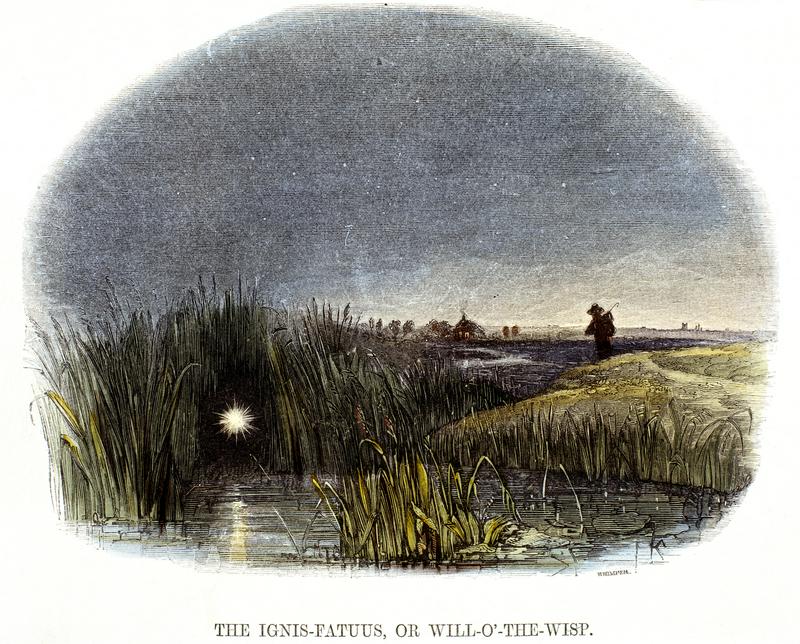Will-O'-The Wisp: Deadly Fairy Lights
By | August 5, 2019

For thousands of years, people all over the world, but particularly in the British Isles, have reported seeing ghostly lights in the night forest and fields. It wasn't just the good British ale: The lights were real ... sort of. They looked just like a flame from a lantern, so nighttime travelers were often lured off their path to go see if the other person needed help. But that's when the trouble would start. The Will-o'-the-wisp, as the strange lights were called, were deceitful and dangerous. Let's see how.

Foolish Fire
The Will-o'-the-wisp were sometimes called "ignis fatuus," a Latin phrase meaning "foolish fire." That's because the fire was not real, only an illusion. The Will-o'-the-wisp could appear as a flickering flame in the moors or wooded areas or as a floating ball of blue-green light near swamps, bogs, or marshes. Some accounts of Will-o'-the-wish sightings claim the light was so bright that it caused people to squint. Other times, the lights were said to be so dim that they could barely be seen. This was, of course, before glasses were invented, so take such accounts with a grain of salt.

A Luring Light
According to most legends, the Will-o'-the-wisp initially appear harmless or even playful, but this is a dirty trick. They were really malevolent, it was said, and served as a device to lure travelers off the beaten path and into danger. On the other hand, some stories claim that the Will-o'-the-wisp led them to the fairy kingdom, so hey, it was a 50-50 shot at partying with sparkle people or certain death. Perhaps some of the ancient bodies found in England's bogs were people who followed a Will-o'-the-wisp away from the well-established path and into a bog or pit. Other travelers simply vanished and were never seen again.

The Origin of the Will-o'-the-Wisp
According to legend, the phantom lights started with a mischievous blacksmith named Will who caused all kinds of trouble during his lifetime. When he died and met Saint Peter at the Pearly Gates, the saint told Will that he was not worthy of gaining entry into heaven. He sent Will back to Earth to prove himself in a second life, but Will made even more of a mess his second time around. Saint Peter 86'd him from the afterlife permanently, leaving Will to roam the Earth with no place to go. The Devil took pity on him and offered him a piece of burning brimstone to keep himself warm, but Will used it instead to lure people to their doom. What a jerk.

Not Just Beacons of Doom
Will-o'-the-wisps were said to be more than just bizarre beacons that led people astray. Their appearances also predicted the future. Seeing a Will-o'-the-wisp could be an omen of death. Some of the stories also say that the Will-o'-the-wisp appears to show people their intended path in life. They could also reveal the spot where a fairy or leprechaun has buried treasure.

Phantom Lights: A Global Phenomenon
The strange phantom lights of a Will-o'-the-wisp are not just a British phenomenon. They have been observed all over the world. In nearly every case, the stories and legends connect them to the spirits of lost souls who are trapped between heaven and hell. For example, in the Netherlands, the "irrbloss" are the souls of unbaptized children, and the lights trick people into going into water where they can be baptized. The "Aleya" of Asia are strange lights that, according to legend, haunt the spot where a person died. The South American "luz mala" are the spirits of the dead who carry phantom lights. In Creole tradition in Louisiana, the "fifollet" are the illuminated souls of people who have been sent back to Earth from heaven to atone for their wicked ways.

Literary Lights
We find references to Will-o'-the-wisps in many works of literature, including those of William Shakespeare, Bram Stoker, and John Milton. In more modern times, there are Will-o'-the-wisps in the Lord of the Rings trilogy by J.R.R. Tolkein and the Harry Potter series by J.K. Rowling. Even Disney found a way to use Will-o'-the-wisps as a plot device. They are featured in the Disney animated film Brave.

A Basis in Science
Though it seems like so many drunken tall tales, science may have actually discovered the secret of the Will-o'-the-wisps. In some cases, sightings of the phantom lights could be attributed to glowing bioluminescent mushrooms and algae that commonly grow in some marshy areas. Under the right conditions, these fungi can produce a bluish light. Other cases of Will-o'-the-wisps can be chalked up to swamp gas. This is caused by the decomposition of plant material in wet, swampy areas. The decomposition process releases methane that spontaneously combusts when it comes in contact with air, creating a burning orb floating above the marsh. It may not be lies, but it appears that it is a load of hot air.

